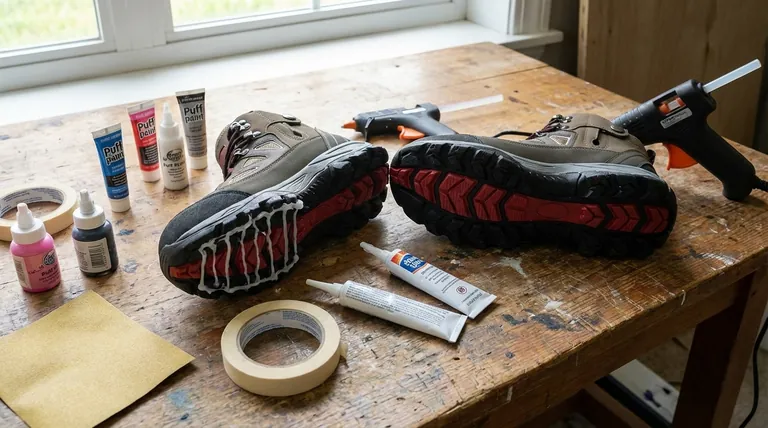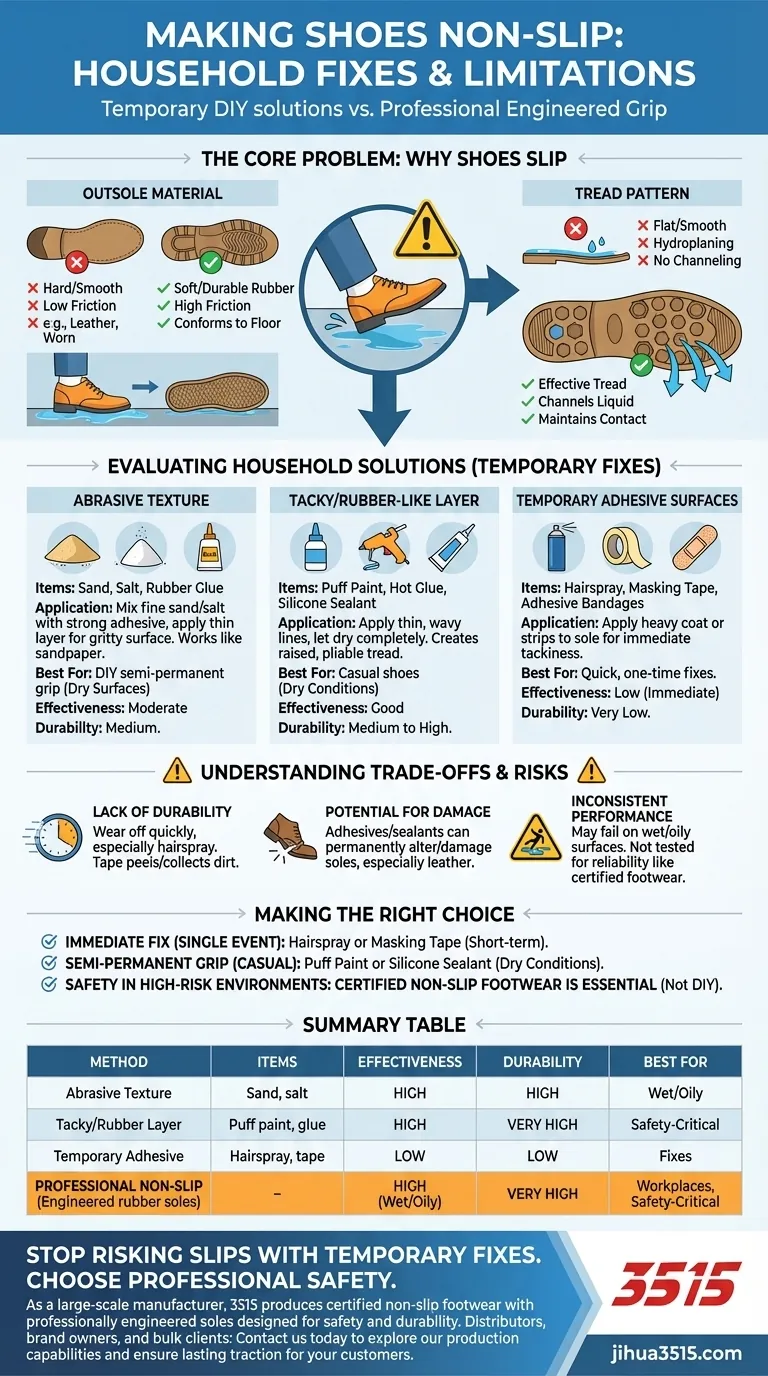To immediately add grip to slippery shoes, you can use several household items to create a more abrasive or tacky sole surface. Common temporary fixes include applying a coat of hairspray or sticking on masking tape, while more durable options involve creating texture with puff paint, silicone sealant, or a hot glue gun.
While household items can provide a temporary patch for slippery soles, they are fundamentally a workaround, not a solution. True non-slip performance comes from a shoe's core design—the material and tread of its outsole—and understanding this distinction is key to ensuring your safety.

The Core Problem: Why Shoes Slip
Before attempting a fix, it's crucial to understand the two factors that govern a shoe's grip: the outsole's material and its tread pattern. Most household solutions attempt to mimic one or both of these features.
The Role of Outsole Material
Hard, smooth materials like leather or worn-down synthetic soles have very little friction. They easily glide over smooth surfaces like tile or polished wood.
Professionally designed non-slip shoes use a soft but durable rubber compound. This material is pliable enough to press into the microscopic imperfections of a floor, maximizing surface contact and creating a high coefficient of friction.
The Importance of Tread Pattern
A flat, smooth sole is highly susceptible to hydroplaning. When a thin layer of water, oil, or other liquid gets between the shoe and the floor, you lose all traction.
Effective tread patterns, often using shapes like hexagons or circles, are engineered to do one job: channel liquids out from under the shoe. This ensures the soft rubber of the sole makes direct contact with the floor, maintaining grip even on wet surfaces.
Evaluating Household Solutions for Grip
Different household items work in different ways, offering varying levels of effectiveness and durability. They can be broadly categorized into three groups.
Adding an Abrasive Texture
This method works by roughing up the sole's surface, similar to how sandpaper works.
- Items: Sand, salt, rubber glue.
- Application: You can mix fine sand or salt with a strong adhesive like rubber glue and apply a thin layer to the sole. The goal is to create a gritty, high-friction surface.
Applying a Tacky or Rubber-Like Layer
This approach adds a new, softer material to the bottom of the shoe, mimicking the grip of a rubber sole.
- Items: Puff paint, hot glue, silicone sealant.
- Application: Applying thin, wavy lines of these materials and letting them dry completely creates a raised, pliable tread. This new texture provides better grip on smooth, dry surfaces.
Using Temporary Adhesive Surfaces
These are the quickest but least reliable fixes, relying on the stickiness of an adhesive.
- Items: Hairspray, masking tape, adhesive bandages.
- Application: A heavy coat of hairspray can create a temporary sticky film. Likewise, applying strips of masking tape or adhesive pads to the sole can add immediate, short-term traction.
Understanding the Trade-offs and Risks
While these DIY methods can help in a pinch, it is critical to recognize their limitations to avoid a false sense of security.
Lack of Durability
Nearly all household solutions are temporary. Hairspray can wear off in under an hour of walking. Tape will peel and collect dirt. Even more robust applications like puff paint will eventually wear down with use.
Potential for Damage
Adhesives, glues, and sealants can permanently alter or damage your shoe's original sole. This is especially true for delicate materials like leather.
Inconsistent Performance
A fix that works on a dry wood floor may fail completely on a wet or oily surface. These methods are not engineered or tested for reliability across different conditions, unlike certified non-slip footwear.
Making the Right Choice for Your Goal
Your choice of method should depend entirely on your specific need and acceptable level of risk.
- If you need an immediate fix for a single event: Hairspray or masking tape can provide temporary tackiness, but expect it to wear off very quickly.
- If you want to add semi-permanent grip to a casual shoe: Applying thin lines of puff paint or silicone sealant offers a more durable, rubber-like texture for dry conditions.
- If your primary concern is safety in a work or high-risk environment: DIY solutions are not an appropriate substitute for certified non-slip footwear with professionally designed soles.
Ultimately, addressing slippery footwear is about choosing the right tool for the job to ensure your stability and confidence.
Summary Table:
| Method | Household Items | Effectiveness | Durability | Best For |
|---|---|---|---|---|
| Abrasive Texture | Sand, salt, rubber glue | Moderate (dry surfaces) | Medium | DIY semi-permanent grip |
| Tacky/Rubber Layer | Puff paint, hot glue, silicone | Good (dry surfaces) | Medium to High | Casual shoes, dry conditions |
| Temporary Adhesive | Hairspray, masking tape | Low (immediate, short-term) | Very Low | Quick, one-time fixes |
| Professional Non-Slip | Engineered rubber soles | High (wet/oily surfaces) | Very High | Workplaces, safety-critical environments |
Stop risking slips with temporary fixes. As a large-scale manufacturer, 3515 produces certified non-slip footwear with professionally engineered soles designed for safety and durability. Whether you're a distributor, brand owner, or bulk client, we offer a comprehensive range of shoes and boots tailored to your needs. Contact us today to explore our production capabilities and ensure lasting traction for your customers.
Visual Guide

Related Products
- Safety Footwear Wholesale Manufacturer for Custom OEM/ODM Production
- Durable Rubber-Soled Utility Shoes for Wholesale & Custom Brand Manufacturing
- Premium Safety Shoes with Rotating Buckle Safety Sneakers
- Wholesale Premium Waterproof Nubuck Safety Shoes Boots
- Durable Canvas Work Shoes with Rubber Lug Sole | Wholesale Manufacturer
People Also Ask
- What are the cultural perspectives on wearing shoes in the house? A Guide to Home Etiquette & Hygiene
- How do safety shoes contribute to cost savings for companies? A Strategic Investment in Risk and Cost Management
- Is safety-toe as good as steel toe? Choose the Right Protection for Your Job
- How long can you wear safety boots? The Lifespan is Determined by Wear, Not Time
- Is it normal to wear shoes in the house? A Guide to Hygiene, Comfort & Culture



















